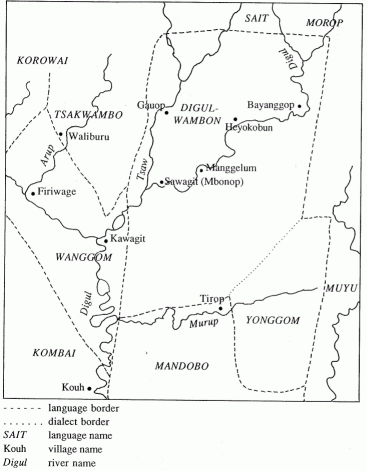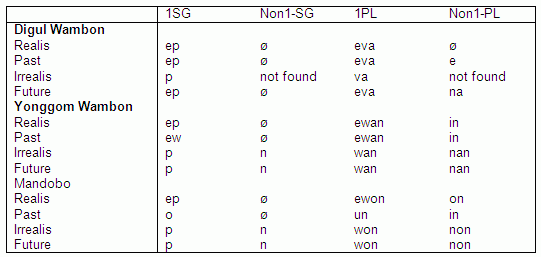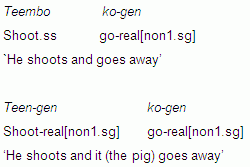Mandobo
Language Background
Mandobo, as described by Drabbe (1959) is spoken by around 3000 speakers that live between the Kao and Digul rivers. Mandobo is also known under the name ‘Kaeti’, which is the name used by Drabbe, whereas ‘Mandobo’ is used by Boelaars (1970). Drabbe notes that Mandobo at first sight seems to be related to its eastern neighbor Kati (also known as Muyu), but that a closer look reveals that it is related to its western Awyu neighbors instead. Mandobo, like Digul Wambon and Yonggom Wambon, is a Ndumut language.

[geographical location of Ndumut languages]
Some Language Facts
The Mandobo verb structure is much like that of both Digul Wambon and Yonggom Wambon. It consists of a verb stem + mood marker + person-number + tense marker, with less finite forms also occurring. Mandobo verbs occur in realis and irrealis forms, as well as in past and future tense. The person-number markers used in each of these moods and tenses is given in the table below, as well as the person-number markers of Digul Wambon and Yonggom Wambon.

Even a quick glance at these person-number markers confirms that Mandobo, Digul Wambon and Yonggom Wambon are closely related.
Switch Reference
Switch reference is an areal feature of Papuan languages. Its function is to “indicate whether or not the subject of a verb is identical with the subject of some other verb” (Haiman & Munroe 1983:ix). The way switch reference works is that a verb is marked differently morphologically when the next verb has a different subject than when the next verb has the same subject. The same-subject (SS) verb forms are often less complex than the different subject (DS) verb forms. Switch reference in Awyu-Ndumut languages is only marked on medial verbs, not final verbs; the final verb will always have a person-number marker that indicates its subject. Two sentences from Mandobo illustrate how switch reference works:

In the first sentence, the subject of the two verbs are the same, whereas in the second sentence, there is a switch in subject between the first and the second verb. Thus teen-gen is a different subject form and teembo a same subject form. The main difference between Mandobo same subject and different subject forms is the occurrence of a mood marker as well as a person-number marker on the different subject forms that do not occur on the same subject forms (even though in this example the person-number is ø-marked).
